
North Bend Plantation is an estate located on the north bank of the James River in Charles City County, Virginia. It is located along State Route 5, a scenic byway which runs between the independent cities of Richmond and Williamsburg.

Sabine Hall is a historic house located near Warsaw in Richmond County, Virginia. Built about 1730 by noted planter, burgess and patriot Landon Carter (1710–1778), it is one of Virginia's finest Georgian brick manor houses. Numerous descendants served in the Virginia General Assembly. It was added to the National Register of Historic Places in 1969, and declared a National Historic Landmark in 1970. At the time of its National Register listing, it was still owned by Carter / Wellford descendants.

The Oak Hill is a historic plantation house located at Colonial Heights, Virginia. It was built in 1825–1826, and is a one-story, frame dwelling with Greek Revival style interior decorative details. It originally had an "H" shape, but was subsequently expanded with several additions. It features a distinctive elongated octagonal wing at the west end, inspired by nearby Violet Bank.
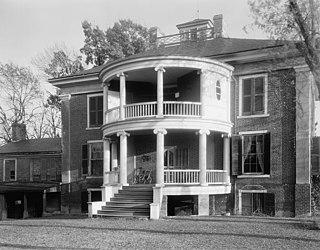
Monticola is a historic plantation home and farm located along the James River near Howardsville, Albemarle County, Virginia. The house was built in 1853 for planter, merchant and banker Daniel James Hartsook, and is a three-story, three-bay, brick Greek Revival style dwelling. The front facade features a central, two-story, pedimented portico. The rear facade has a semi-circular, two-level, porch with Colonial Revival details. It was added about 1890 by Prussian born Richmond tobacco exporter, Emil Otto Nolting, who had purchased the estate three years earlier in 1887.

Limestone, also known as Limestone Plantation and Limestone Farm, has two historic homes and a farm complex located near Keswick, Albemarle County, Virginia. The main dwelling at Limestone Farm consists of a long, narrow two-story central section flanked by two wings. the main section was built about 1840, and the wings appear to be two small late-18th-century dwellings that were incorporated into the larger building. It features a two-story porch. The house underwent another major renovation in the 1920s, when Colonial Revival-style detailing was added. The second dwelling is the Robert Sharp House, also known as the Monroe Law Office. It was built in 1794, and is a 2+1⁄2-story, brick and frame structure measuring 18 feet by 24 feet. Also on the property are a contributing shed (garage), corncrib, cemetery, a portion of a historic roadway, and a lime kiln known as "Jefferson's Limestone Kiln" (1760s). Limestone's owner in the late-18th century, Robert Sharp, was a neighbor and acquaintance of Thomas Jefferson. The property was purchased by James Monroe in 1816, after the death of Robert Sharp in 1808, and he put his brother Andrew Monroe in charge of its administration. The property was sold at auction in 1828.

Olive Hill is a historic plantation house located near Matoaca in Chesterfield County, Virginia. It was built in 1740, and is a two-story, five-bay-wide, white frame house in the Georgian style. The original structure measures 38 by 32 feet. It is sheathed in molded weatherboard and topped by a pedimented roof. The interior features a Chinese lattice stair with a molded hand rail.
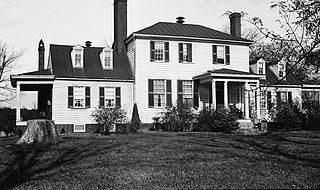
Burnt Quarter is a historic plantation house located near Dinwiddie, Dinwiddie County, Virginia. It was built in stages starting about 1750, and consists of a two-story, hipped roof central section flanked by 1+1⁄2-story wings. On April 1, 1865, the property became the scene of the decisive Battle of Five Forks. During the battle the house served both as headquarters for Union General Merritt and as a military hospital. On the grounds is a monument to six unknown Confederate soldiers killed in the Battle of Five Forks.

Glen Arvon, originally known as Glenarvon, is a historic plantation house and farm located near Bremo Bluff, Fluvanna County, Virginia. The main house was built in 1836, and is a two-story, five-bay, brick dwelling in the Greek Revival style. It measures 50 feet by 40 feet and is topped by a shallow hipped roof with balustrade. The front facade features a two-story Greek Doric order portico. Also on the property is the contributing two-story, brick servant's house. The house is a twin of Point of Fork, as they were built by brothers William and James Galt.

Waverly is a historic home and farm located near Burnt Chimney, Franklin County, Virginia. It was built beginning about 1853 for Armistead Lewis Burwell (1809-1883) and his family, who inherited it from the parents of his wife, Mary Hix (1811-1895). Descended from the First Families of Virginia, Armistead L. Burwell operated a tobacco and grain plantation of about 350 improved acres using enslaved labor, and also had a chewing tobacco factory, gristmill and sawmill by 1860. His son William A. Burwell (1836-1882) ran the factory and bought the plantation from his father in 1864, and sold it in 1868 to his younger brother John Spotswood Burwell who operated a dairy farm until after the turn of the century.
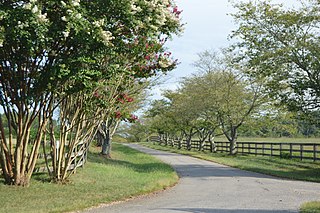
Bolling Hall is a historic home located near Goochland, Goochland County, Virginia. The original section was built before 1799 as a two-story, frame structure measuring 34 feet by 22 feet. This was the main house of a property developed as a plantation. The house was expanded in 1803, and expanded again by 1815. It was extensively remodeled and expanded between 1845 and 1861.
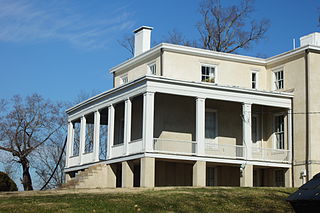
Elk Hill, also known as Harrison's Elk Hill, is a historic plantation home located near Goochland, Goochland County, Virginia. It was built between 1835 and 1839, and is a 2+1⁄2-story, three-bay, stuccoed brick central-hall-plan house in the Greek Revival style. It has a two-story rear ell. The front facade features a one-story Tuscan order portico consisting of paired rectangular wooden pillars supporting a full entablature. Also on the property are the contributing servants' quarters, tack house, and spring house. It was listed on the National Register of Historic Places in 1979.

Brightly is a historic plantation house located near Goochland, Goochland County, Virginia. The main dwelling was built about 1842, and is a two-story, single pile, central-passage-plan, gable-roofed brick dwelling in the Greek Revival style. The front facade features a one-story, one-bay Greek Revival Doric order porch. Also on the property are the contributing pair of slave dwellings, privy, granary, chicken house, barn, well house, windmill, cemetery and the gate posts.

Oakley Hill is a historic plantation house located near Mechanicsville, Hanover County, Virginia. It was built about 1839 and expanded in the 1850s. It is a two-story, frame I-house dwelling in the Greek Revival style. On the rear of the house is a 1910 one-story ell. The house sits on a brick foundation, has a standing seam metal low gable roof, and interior end chimneys. The front facade features a one-story front porch with four Tuscan order columns and a Tuscan entablature. Also on the property are a contributing smokehouse and servants' house.

Belleview is a historic plantation house located near Ridgeway, Henry County, Virginia. It was built about 1783, and is a two-story, five-bay, frame dwelling with a gable roof. It has an original two-story ell and a sun porch and one-story wing added in the mid-1950s. The front facade features a two-tier portico supported by slender Greek Ionic order columns.

Stirling, also known as Stirling Plantation, is a historic plantation house located near Massaponax, Spotsylvania County, Virginia. It was built between 1858 and 1860, and is a 2+1⁄2-story, five-bay, brick Greek Revival and Federal dwelling. It measures 56 feet by 36 feet, and has a hipped roof and four interior end chimneys. It sits on a raised basement and features entrance porches added about 1912. Also on the property are the contributing kitchen dependency, smokehouse, family cemetery, and the undisturbed archaeological sites of a weaving house and three slave cabins.

Long Meadow is a historic home located at Middletown, Warren County, Virginia. The home is located on the North Fork of the Shenandoah River and is in the shadow of Massanutten Mountain, in clear view of Signal Knob. The original homestead was one of the first settlements in the Valley and has been owned by three different families since the original house was built in the 1730s.

Arnheim is a historic plantation house located at Radford, Virginia. It was built between 1838 and 1840, and is a two-story, three-bay, Federal / Greek Revival–style brick dwelling. It is a symmetrical double-pile plan dwelling, 40 feet square, and sitting on a raised brick basement. In 1939, it was converted into a home economics annex for the adjacent Radford High School. Arnheim was built by Dr. John Blair Radford, for whom the City of Radford is named. The property also includes a documented contributing archaeological site.

Monterey is a historic plantation house located at Roanoke, Virginia. It was built about 1845, and is a two-story, banked, Greek Revival style brick dwelling with a spreading hipped roof. Two additions were made to the original house after 1871, which gives it an "L"-shape. The front facade features a full-width verandah style porch and the rear has a two-story gallery. Also on the property is a contributing smoke house.
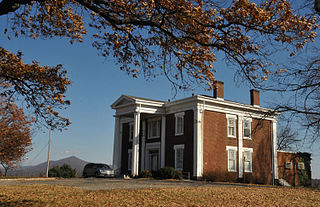
Buena Vista is a historic plantation house located in Roanoke, Virginia. It was built about 1840, and is a two-story, brick Greek Revival style dwelling with a shallow hipped roof and two-story, three-bay wing. The front facade features a massive two-story diastyle Greek Doric order portico. Buena Vista was built for George Plater Tayloe and his wife, Mary (Langhorne) Tayloe. George was the son of John Tayloe III and Anne Ogle Tayloe of the noted plantation Mount Airy in Richmond County and who built The Octagon House in Washington D.C. The property was acquired by the City of Roanoke in 1937, and was used as a city park and recreation center.
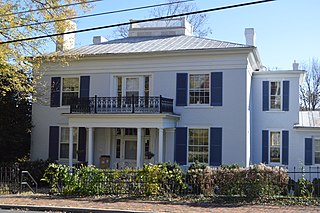
Thomas J. Michie House is a historic home located at Staunton, Virginia. It was built in 1847–1848, and is a three-story, three-bay, Greek Revival style brick dwelling with a two-story wing. The total size is 7,100 square feet. The front facade features a one-story, flat-roofed entrance porch supported by four slender Tuscan order columns. The interior has two elaborate country Federal mantels taken from a nearby 1820 country home. It was built by Thomas J. Michie, who represented Augusta County in the Virginia House of Delegates and may be of the same family that built Michie's Tavern in Charlottesville, Virginia as well as Michie Stadium at West Point Military Academy. It was later the home of jurist Allen Caperton Braxton (1862-1914) and Henry W. Holt (1864-1947) who was the Chief Justice of the Virginia Supreme Court.
























